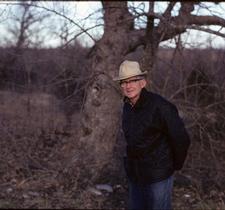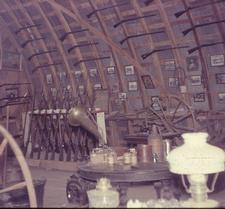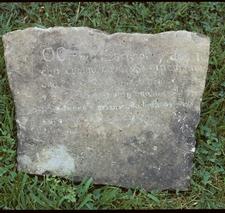Spanish Mystery Stone
 Many families have lived on portions of the Wilson’s Creek battlefield through the decades. Perhaps no individual has been more interesting than Dick “Dixie” O’Connor, who bought a farm near “Bloody Hill” in 1950. O’Connor had a life long interest in regional history and began collecting guns as a child. O’Connor became a recognized authority on local history, but his rivalry with a professional historian led him to create the “Spanish Mystery Stone,” one of the Ozark’s greatest hoaxes.
Many families have lived on portions of the Wilson’s Creek battlefield through the decades. Perhaps no individual has been more interesting than Dick “Dixie” O’Connor, who bought a farm near “Bloody Hill” in 1950. O’Connor had a life long interest in regional history and began collecting guns as a child. O’Connor became a recognized authority on local history, but his rivalry with a professional historian led him to create the “Spanish Mystery Stone,” one of the Ozark’s greatest hoaxes.
Area residents actively searched for relics on the site before it became a unit of the National Park Service in 1961. O’Connor was certainly the most successful as he recovered thousands of artifacts from the battlefield. An early metal detector, built by his son who worked as an inventor for Bell Laboratories in Indianapolis, Indiana, greatly enhanced O’Connor’s searching. Soon he had a barn filled with thousands of relics, though not all were from the Civil War, or the Battle of Wilson’s Creek. The barn also displayed O’Connor’s large gun collection. Called the Wilson’s Creek Museum, O’Connor’s barn, the Lyon Monument, and the Ray House were the battlefield’s notable attractions in the 1950s.
Meanwhile, local historians and  businessmen organized the Wilson’s Creek Foundation in 1950. Their goal was to purchase 37 acres on Bloody Hill for the establishment of a national park. O’Connor also wanted this key tract of land and he soon clashed with Dr. Lewis Meador, a leading figure in the foundation. Dr. Meador spoke to the local newspaper where he estimated the value of the O’Connor property. Worse yet, in O’Connor’s eyes, he dismissed the museum and declared it had little value to the site.
businessmen organized the Wilson’s Creek Foundation in 1950. Their goal was to purchase 37 acres on Bloody Hill for the establishment of a national park. O’Connor also wanted this key tract of land and he soon clashed with Dr. Lewis Meador, a leading figure in the foundation. Dr. Meador spoke to the local newspaper where he estimated the value of the O’Connor property. Worse yet, in O’Connor’s eyes, he dismissed the museum and declared it had little value to the site.
Hurt and angered by Meador’s attitude, O’Connor vowed to get even by exploiting the long held idea among treasure hunters that Spanish gold was hidden in Missouri. O’Connor had previously lived in Texas with his brother where he learned Spanish. Now was the time, he thought, to leave a message with clues about where to find supposedly hidden riches. He removed a large, flat, limestone rock from his rose garden and allowed his family to throw coffee grounds, potato peelings and other trash over it. One of his kids thought they were making a compost pile. Instead, they were aging the rock and when it was finished, O’Connor broke it in half. O’Connor then carved a cryptic message about gold and silver into the stone. His inscription read: “Eight Spaniard and Two [illegible] with four horses and five mules, god and silver, licensed Pueblo Ysleta 4th of June, 1799 by Saint Louis of Illinois. Here French and American thieves [illegible] Spaniard and [illegible] I am [illegible]"
 When the inscription was complete, O’Connor gave the stone to an unnamed man from St. Louis who dropped it in Wilson’s Creek, near where it crosses the Old Wire Road. There it lay until November 17, 1965, when David Cavender, who was hiking through the park with his Boy Scout group, discovered it. Cavender and the other boys quickly turned it over to the National Park Service. Historians and language specialists examined the stone, but they were unable to decipher its meaning. Soon treasure hunters and curious locals were visiting the battlefield to get a glimpse of the “Spanish Mystery Stone.”
When the inscription was complete, O’Connor gave the stone to an unnamed man from St. Louis who dropped it in Wilson’s Creek, near where it crosses the Old Wire Road. There it lay until November 17, 1965, when David Cavender, who was hiking through the park with his Boy Scout group, discovered it. Cavender and the other boys quickly turned it over to the National Park Service. Historians and language specialists examined the stone, but they were unable to decipher its meaning. Soon treasure hunters and curious locals were visiting the battlefield to get a glimpse of the “Spanish Mystery Stone.”
The legend grew faster than O’Connor ever imagined. Worse yet, his intended target, Dr. Meador, had nothing to do with its identification. O’Connor visited the battlefield and told a park ranger how he made the stone. Considering his reputation, it is not surprising nobody believed him. In a 1971 written statement, O’Connor once again acknowledged his role in the stone’s creation, though he denied placing it in the creek. Most of his confession however, was actually an attack on area professors and other persons interested in local history.
Serious researchers now accept O’Connor’s confession and the “Spanish Mystery Stone” is just a popular legend. Still, it remains a fascinating story about the creation and early days of Wilson’s Creek National Battlefield. Finally, a wealth of primary source material about Spanish activities in Missouri is available in The Spanish Regime in Missouri by Louis Houck. Click on any of the above images to make them larger.
Find this article at http://thelibrary.org/blogs/article.cfm?aid=1154&lid=0